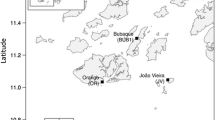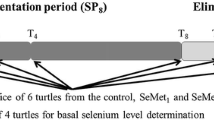Abstract
Ecotoxicological data in reptiles are mainly represented by field studies reporting the tissue burden of wild-captured individuals but much less is known regarding the processes of uptake, depuration, accumulation and the effects of inorganic contaminants in these species. In the present study, the accumulation, the path and the effects of exposure to cadmium (Cd) through diet intake were investigated in female red eared slider turtles, Trachemys scripta elegans. In the first phase of the experiment, turtles underwent an acclimatization period during which they were fed a control diet. In the second phase, the turtles were exposed to cadmium through a CdCl2 supplemented-diet with increased environmentally relevant concentrations for a period of 13 weeks. Following this, the turtles went through a third phase, a recovery phase of 3 weeks, during which they were fed uncontaminated food. Blood and feces were collected during the three phases of the experiment. The turtles were euthanized at the end of the experiment and organ samples collected. The Cd-concentrations in blood remained stable over the course of the experiment while Cd-concentrations in feces increased with time and with the amount of Cd ingested. The proportional accumulation in liver and kidney together was comprised between 0.7 and 6.1% and they represented the main organs of accumulation. Cd accumulated in the organs in the following order of concentration: kidney > liver > pancreas > muscle. In terms of burden in organs, the Cd-burden was the highest in liver followed by kidney and pancreas. The proportional accumulation decreased as Cd ingestion increased, suggesting that at a higher dose of Cd, assimilation decreased. Mineral content of the liver and pancreas became modified according to Cd level; increasing dietary Cd exposure increased concentrations of zinc and iron in liver and copper in pancreas in a dose-dependent manner. Accumulation of Cd had no effect on survival, food consumption, growth, weight or length suggesting no effect of the treatment on female turtle body condition.




Similar content being viewed by others
References
Andersen O, Nielsen JB, Nordberg GF (2004) Nutritional interactions in intestinal cadmium uptake: possibilities for risk reduction. Biometals 17:543–547
Ando M, Hiratsuka H, Nakagawa J, Sato S, Hayashi Y, Mitsumori K (1998) Cadmium accumulation in rats treated orally with cadmium chloride for 8 months. J Toxicol Sci 23:243–248
Beckett WS, Nordberg GF, Clarkson TW (2007) Routes of exposure, dose, and metabolism of metals. In: Nordberg GF, Fowler BA, Nordberg M, Friberg LT (eds) Handbook on the toxicology of metals, 3rd edn. Academic Press, pp 39–64
Bertin G, Averbeck D (2006) Cadmium: cellular effects, modifications of biomolecules, modulation of DNA repair and genotoxic consequences (a review). Biochimie 88:1549–1559
Beyersmann D, Hartwig A (2008) Carcinogenic metal compounds: recent insight into molecular and cellular mechanisms. Arch Toxicol 82:493–512
Beyersmann D, Hechtenberg S (1997) Cadmium, gene regulation, and cellular signalling in mammalian cells. Toxicol Appl Pharmacol 144:247–261
Bishop CA, Ng P, Pettit KE, Kennedy SW, Stegeman JJ, Norstrom RJ, Brooks RJ (1998) Environmental contamination and developmental abnormalities in eggs and hatchlings of the common Snapping Turtle (Chedlydra serpentine serpentina) from the Great Lakes-St. Lawrence River basin (1989–1991). Environ Pollut 101:143–156
Burger J (2008) Assessment and management of risk to wildlife from cadmium. Sci Total Environ 389:37–45
Chan HM, Kim C, Leggee D (2001) Cadmium in caribou (Rangifer tarandus) kidneys: speciation, effects of preparation and toxicokinetics. Food Addit Contam 18:607–614
Chan DY, Fry N, Waisberg M, Black WD, Hale BA (2004) Accumulation of dietary cadmium (Cd) in rabbit tissues and excretions: a comparison of lettuce amended with soluble Cd salt and lettuce with plant-incorporated Cd. J Toxicol Env Health Part A 67:397–411
Croteau MN, Luoma SN, Stewart AR (2005) Trophic transfer of metals along freshwater food webs: evidence of cadmium biomagnification in nature. Limnol Oceanogr 50:1511–1519
de Solla SR, Fernie KJ, Letcher RJ, Chu SG, Drouillard KG, Shahmiri S (2007) Snapping turtles (Chelydra serpentina) as bioindicators in Canadian areas of concern in the Great Lakes Basin. I. Spatial distribution of PBDEs, PCBs, and organochlorine pesticides in eggs (Chelydra serpentina). Environ Sci Technol 41:7252–7259
de Vries W, Romkens P, Schutze G (2007) Critical soil concentrations of cadmium, lead, and mercury in view of health effects on humans and animals. Rev Environ Contam Toxicol 191:91–130
Ganser LR, Hopkins WA, O’Neil L, Hasse S, Roe JH, Sever DM (2003) Liver histopathology of the southern watersnake, Nerodia fasciata fasciata, following chronic exposure to trace element-contaminated prey from a coal ash disposal site. J Herpetol 37:219–226
Gibbons JW, Scott DE, Ryan TJ, Buhlmann KA, Tuberville TD, Metts BS, Greene JL, Mills T, Leiden Y, Poppy S, Winne CT (2000) The global decline of reptiles, Deja Vu amphibians. Bioscience 50:653–666
Gregus Z, Klaassen CD (1986) Disposition of metals in rats: a comparative study of fecal, urinary, and biliary excretion and tissue distribution of 18 Metals. Toxicol Appl Pharmacol 85:24–38
Groten JP, Sinkeldam EJ, Luten JB, Vanbladeren PJ (1991) Cadmium accumulation and metallothionein concentrations after 4-week dietary exposure to cadmium chloride or cadmium metallothionein in rats. Toxicol Appl Pharmacol 111:504–513
Hispard F, de Vaufleury A, Cosson RP, Devaux S, Scheifler R, Coeurdassier M, Gimbert F, Martin H, Richert L, Berthelot A, Badot PM (2008) Comparison of transfer and effects of Cd on rats exposed in a short experimental snail-rat food chain or to CdCl2 dosed food. Environ Int 34:381–389
Hopkins WA (2000) Reptile toxicology: challenges and opportunities on the last frontier in vertebrate ecotoxicology. Environ Toxicol Chem 19:2391–2393
Hopkins WA (2006) Use of residues in reptile ecotoxicology: a call for integration and experimentalism. In: Gardner SC, Oberdörster Z (eds) Toxicology of reptiles. CRC, Boca Raton, pp 35–62
Hopkins WA, Roe JH, Snodgrass JW, Jackson BP, Kling DE, Rowe CL, Congdon JD (2001) Nondestructive indices of trace element exposure in squamate reptiles. Environ Pollut 115:1–7
Hopkins WA, Roe JH, Snodgrass JW, Staub BP, Jackson BP, Congdon JD (2002) Effects of chronic dietary exposure to trace elements on banded water snakes (Nerodia fasciata). Environ Toxicol Chem 21:906–913
Jarup L (2003) Hazards of heavy metal contamination. Br Med Bull 68:167–182
Jarup L, Berglund M, Elinder CG, Nordberg G, Vahter M (1998) Health effects of cadmium exposure: a review of the literature and a risk estimate. Scand J Work Environ Health 24(suppl 1):52
Klaassen CD, Liu J, Choudhuri S (1999) Metallothionein: an intracellular protein to protect against cadmium toxicity. Annu Rev Pharmacol Toxicol 39:267–294
Lind Y, Engman J, Jorhem L, Glynn AW (1997) Cadmium accumulation in liver and kidney of mice exposed to the same weekly cadmium dose continuously or once a week. Food Chem Toxicol 35:891–895
Liu J, Liu Y, Michalska AE, Choo KHA, Klaassen CD (1996) Distribution and retention OD cadmium in metallothionein I and II null mice. Toxicol Appl Pharmacol 136:260–268
Lopez E, Arce C, Oset-Gasque MJ, Canadas S, Gonzalez MP (2006) Cadmium induces reactive oxygen species generation and lipid peroxidation in cortical neurons in culture. Free Radic Biol Med 40:940–951
Mann RM, Serra EA, Soares A (2006) Assimilation of cadmium in a European lacertid lizard: is trophic transfer important? Environ Toxicol Chem 25:3199–3203
Mann RM, Sanchez-Hernandez JC, Serra EA, Soares A (2007) Bioaccumulation of Cd by a European lacertid lizard after chronic exposure to Cd-contaminated food. Chemosphere 68:1525–1534
Matsuno K, Kodama Y, Kawamoto T, Kayama F, Tsuchiya K (1991) Absorption of cadmium after a long-term oral-administration of cadmium to dogs. Biol Trace Elem Res 28:99–108
Nagle RD, Rowe CL, Congdon JD (2001) Accumulation and selective maternal transfer of contaminants in the turtle Trachemys scripta associated with coal ash deposition. Arch Environ Contam Toxicol 40:531–536
Nakagawa J, Oishi S, Suzuki J, Tsuchiya Y, Ando M, Fujimoto Y (2004) Effects of long-term ingestion of cadmium-polluted rice or low-dose cadmium-supplemented diet on the endogenous copper and zinc balance in female rats. J Health Sci 50:92–96
Neathery MW, Miller WJ (1975) Metabolism and toxicity of cadmium, mercury and lead in animals, a review. Journal of Dairy Sciences 58:1767–1781
Noel L, Guerin T, Kolf-Clauw M (2004) Subchronic dietary exposure of rats to cadmium alters the metabolism of metals essential to bone health. Food Chem Toxicol 42:1203–1210
Nordberg GF, Nogawa K, Nordberg M, Friberg LT (2007) Cadmium. In: Nordberg GF, Fowler BA, Nordberg M, Friberg LT (eds) Handbook on the toxicology of metals, 3rd edn. Academic Press, Burlington, pp 446–486
Nordic Council of Ministers (NCM) (2003) Cadmium review. www.who.int/ifcs/documents/forums/forum5/nmr_cadmium.pdf. Accessed October 2008
Rie MT, Lendas KA, Callard IP (2001) Cadmium: tissue distribution and binding protein induction in the painted turtle, Chrysemys picta. Comp Biochem Physiol C-Toxicol Pharmacol 130:41–51
Rowe CL, Hopkins WA, Coffman VR (2001) Failed recruitment of southern toads (Bufo terrestris) in a trace element-contaminated breeding habitat: direct and indirect effects that may lead to a local population sink. Arch Environ Contam Toxicol 40:399–405
Schilderman P, Moonen EJC, Kempkers P, Kleinjans JCS (1997) Bioavailability of soil-adsorbed cadmium in orally exposed male rats. Environ Health Perspect 105:234–238
Schwarzenbach RP, Escher BI, Fenner K, Hofstetter TB, Johnson CA, von Gunten U, Wehrli B (2006) The challenge of micropollutants in aquatic systems. Science 313:1072–1077
Simon L, Martin HW, Adriano DC (1996) Chicory (Cichorium intybus L) and dandelion (Taraxacum officinale Web) as phytoindicators of cadmium contamination. Water Air Soil Pollut 91:351–362
Sunda WG, Huntsman SA (1998) Processes regulating cellular metal accumulation and physiological effects: phytoplankton as model systems. Sci Total Environ 219:165–181
Vogiatzis AK, Loumbourdis NS (1998) Cadmium accumulation in liver and kidneys and hepatic metallothionein and glutathione levels in Rana ridibunda, after exposure to CdCl2. Arch Environ Contam Toxicol 34:64–68
Waisberg M, Joseph P, Hale B, Beyersmann D (2003) Molecular and cellular mechanisms of cadmium carcinogenesis. Toxicology 192:95–117
Ward CK, Mendonca MT (2006) Chronic exposure to coal fly ash causes minimal changes in corticosterone and testosterone concentrations in male southern toads Bufo terrestris. Arch Environ Contam Toxicol 51:263–269
Weigel HJ, Jager HJ, Elmadfa I (1984) Cadmium accumulation in rat organs after extended oral-administration with low concentrations of cadmium-oxide. Arch Environ Contam Toxicol 13:279–287
Xu Y, Wang WX (2002) Exposure and potential food chain transfer factor of Cd, Se and Zn in marine fish Lutjanus argentimaculatus. Mar Ecol Prog Ser 238:173–186
Zalups RK, Ahmad S (2003) Molecular handling of cadmium in transporting epithelia. Toxicol Appl Pharmacol 186:163–188
Acknowledgments
We thank JP. Macé from Alligator Bay for providing the turtles for this study. We also thank C. Michel and R. Maréchal for allowing us to use the Aquarium-Museum at the University of Liège and for their valuable technical assistance in reptile maintenance. We are grateful to Olivier Marquis for his advice on reptile maintenance and his help in designing this experimental study. We are also grateful to Stéphane Caut (CSIC, Seville) for his logistical help and helpful advice during the experiment, and to JP. Thomé, P. Poncin, M. Denoël from the University of Liège. Experiments and protocols were submitted to and approved by the Veterinary Committee of the Belgian Ministry of Agriculture. E. Guirlet is in receipt of a postdoctoral grant from the University of Liège and K. Das is an F.R.S.-FNRS Research Associate. This is a MARE publication 212.
Author information
Authors and Affiliations
Corresponding author
Rights and permissions
About this article
Cite this article
Guirlet, E., Das, K. Cadmium toxicokinetics and bioaccumulation in turtles: trophic exposure of Trachemys scripta elegans . Ecotoxicology 21, 18–26 (2012). https://doi.org/10.1007/s10646-011-0758-2
Accepted:
Published:
Issue Date:
DOI: https://doi.org/10.1007/s10646-011-0758-2




